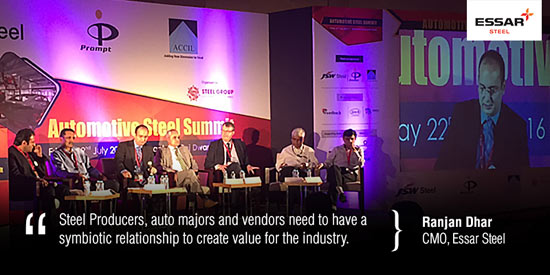The Essar Steel CMO (Chief Marketing Office), Ranjan Dhar, joined other industry experts to deliberate on key issues faced by the Indian steel industry at the 1st Automotive Steel Summit held in New Delhi. The panel also discussed about ways to ensure that “Make in India” was a success.
The recently concluded Summit saw participation from all major steel producers, auto manufacturers and vendors in India. More than 250 people attended. Steel majors showcased their capabilities to automotive industry, a key customer segment. The focus was on apprising the sector on the latest development in import substitute steel.
Essar Steel itself has launched three import substitute steel grades in the last three months, of which one is for automotive customers. In fact, over 23% of Essar Steel’s revenues today is derived from such indigenously developed grades.
At Essar Steel, latest technology is used for steel-making, casting, hot rolling and cold rolling to produce steel fit for the automotive sector. Approximately, 10 percent of Essar’s total volume constitutes of automotive products. The comprehensive portfolio of hot rolled and cold rolled steel products, finds usage in a variety of automotive applications, which includes panels, structural members, reinforcements, pillars, etc.
Mr Dhar was a key speaker and panel member and was joined by his colleague, Mr Satyajit Mohapatra, Head-Application Engineering, Essar Steel. In his address, Mr Dhar said, “Recent import restrictions have led to auto majors fast-track localisation of steel for components that were earlier imported from Japan and Korea, the home countries of many of the automobile companies. This proves that the Indian steel industry always had the capacity and capability to cater to the needs of the sector. Steel producers, auto majors and vendors need to have a symbiotic relationship to create value for the industry.”
Critical issues, like the surge in cheap imports, and the imposition of the BIS certification, which has been opposed by automobile companies, were also discussed at the conference.

